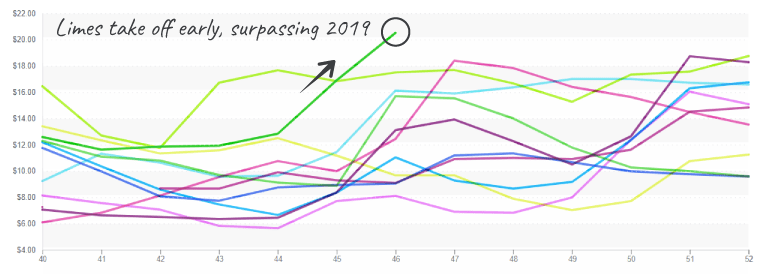Like so many of us who enjoy a good nap after our Thanksgiving meal, produce markets tend to nod off immediately after the festivities. With plenty of leftovers in the average refrigerator, retail slumps faster than you can say tryptophan. Nevertheless, this year is anything but normal. With major truck shortages coming into the holiday season, significant cost inflation, and uncertain demand during our covid-recovering economy, future prices are that much harder to forecast.
Mexico’s fall transition and Nogales’ burgeoning winter season is lining up ominously with national leftovers day. Brace for a dip in prices. Importers will be working hard to prevent the fresh produce Thanksgiving snooze from turning into a full-blown coma.
Up +21 percent over the previous week, lime supply continues to dwindle. Labor issues are causing too few crossings, exasperating an already lean supply. Week #46 prices are at a ten-year high and are signaling that the upward trend may continue through the winter.
(Week #46, ending November 19th)
ProduceIQ Index: $1.02/pound, -1.9 percent over prior week
Limes ascend to a 10-year high for this week #46; limes don’t typically reach higher highs until February. Heavier holiday demand is pushing up Asparagus prices off the floor to $14. A +14 percent increase over the previous week is helpful, yet prices remain at a ten-year low. Asparagus is still the item to promote.
Heavier holiday demand is pushing up Asparagus prices off the floor to $14. A +14 percent increase over the previous week is helpful, yet prices remain at a ten-year low. Asparagus is still the item to promote.
Green beans aren’t breaking records, but they aren’t exactly cheap either. At $23, prices remain in the upper range of historical data for week #46. Supply is lagging slightly behind demand due to weak harvests out of California and Mexico. Florida green bean growers should come online within the next few weeks and provide relief to elevated markets.
Strong demand and weak supply are keeping sweet corn prices at a ten-year high for week #46. Western supply is limited, and Eastern growing regions are experiencing a small gap in production.
Buyers are anxiously waiting on Florida sweet-corn to start. Fortunately, Florida production picked up this week and should provide some relief to markets throughout early December.
Sweet corn prices are above historical norms, though it could be a new long-term trend as both 2019 and 2020 experienced high winter prices.
Thank God for Arizona. Increasing lettuce and leaf production is hemorrhaging inflated prices. Iceberg and spinach are down -31 percent, and romaine is down -7 percent over the previous week. Supply isn’t the only thing that’s improved during the transition to Yuma; reports on quality across all three commodities are better as well. As a result, prices will fall and stabilize over the next few weeks.
Iceberg prices fall as production in Yuma ramps up.
Broccoli just can’t seem to find its way out of our weekly highlights. Up an astounding +56 percent over the previous week, broccoli is quickly becoming the poster child for fresh produce volatility. Quality and limited supply are destabilizing broccoli markets and will continue to do so for the foreseeable future.
Please visit our online marketplace here and enjoy free access to our market tools which created the graphs above.
ProduceIQ Index
 The ProduceIQ Index is the fresh produce industry’s only shipping point price index. It represents the industry-wide price per pound at the location of packing for domestic produce, and at the port of U.S. entry for imported produce.
The ProduceIQ Index is the fresh produce industry’s only shipping point price index. It represents the industry-wide price per pound at the location of packing for domestic produce, and at the port of U.S. entry for imported produce.
ProduceIQ uses 40 top commodities to represent the industry. The Index weights each commodity dynamically, by season, as a function of the weekly 5-year rolling average Sales. Sales are calculated using the USDA’s Agricultural Marketing Service for movement and price data. The Index serves as a fair benchmark for industry price performance.





